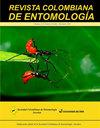茄科(Cestrum parqui)叶提取物对黄颡虫(Coleoptera:Chrysomelidae)成虫的杀虫能力
IF 0.3
4区 农林科学
Q4 ENTOMOLOGY
引用次数: 0
摘要
在智利已报道的一系列外来害虫中,榆树(榆属)的落叶昆虫黄galeruca luteola(鞘翅目:金枝科)对智利中部的城市树木造成了严重的危害。在室内研究了不同浓度的水提取物和乙醇提取物对木犀草成虫的杀虫能力。采用完全随机设计的生物测定法分析每种提取物的效果。同时测定了成熟叶片状态和溶剂的平均致死浓度(LC50)。进行了近端分析,以确定成熟期之间的物理和化学差异。近端分析表明,两叶期粉末的湿度、灰分、脂质和蛋白质含量差异显著(P < 0.01),但粗纤维含量和非氮提取物含量差异不显著。暴露后第3天,各杀虫剂提取物的效价递减顺序为:新乙醇(2.5% w/v)、新水(3.8% w/v)、成熟乙醇(6.7% w/v)、成熟水(9.2% w/v)。本研究结果表明,金桂叶提取物作为生物杀虫剂可能在木犀叶蠹成虫的综合防治计划中有潜在的应用价值,但还需要更大规模的试验来证实我们的结果。本文章由计算机程序翻译,如有差异,请以英文原文为准。
Insecticidal capacity of Cestrum parqui (Solanaceae) leaf extracts on Xanthogaleruca luteola (Coleoptera: Chrysomelidae) adults
Among a series of exotic pests that have been reported in Chile, Xanthogaleruca luteola (Coleoptera: Chrysomelidae), a defoliating insect of elms (Ulmus spp.), is causing important damage in urban trees in central Chile. The insecticidal capacity of water and ethanol extracts obtained from new and mature leaves of Cestrum parqui (Solanaceae) was evaluated at various concentrations on X. luteola adults in the laboratory. Bioassays with a completely randomized design were used to analyze the effects of each extract. Also, the mean lethal concentration (LC50) was determined for both mature leaf states and solvents. A proximal analysis was done to determine the physical and chemical differences between the maturity stages. Proximal analysis of the powder of both leaf stages revealed differences (P < 0.01) in the content of humidity, ashes, lipids, and proteins, but not in the raw fiber content nor the non-nitrogenous extract. On the third day after exposure, the order of decreasing effectiveness (LC50) ofthe insecticide extracts was: new-ethanol (2.5 % w/v), new-water (3.8 % w/v), mature-ethanol (6.7 % w/v) and mature-water (9.2 % w/v). Our results suggest that C. parqui leaf extracts may have potential use as a bioinsecticide in integrated pest management plans for the control of X. luteola adults, however, tests at a larger scale are necessary to confirm our results.
求助全文
通过发布文献求助,成功后即可免费获取论文全文。
去求助
来源期刊
CiteScore
0.90
自引率
0.00%
发文量
25
审稿时长
>12 weeks
期刊介绍:
The Revista Colombiana de Entomología (Rev. Colomb. Entomol.) is the official scientific publication of the Colombian Society of Entomology - SOCOLEN since april of 1975. The journal is published twice a year. Contributions include Original Research Papers, Reviews of Entomological Topics (under a request from the Editorial Board), Taxonomic Papers, Points of View, New Records, Scientific Notes, Book Reviews, and Obituaries. The Revista Colombiana de Entomología welcomes contributions from both national and international researchers, and from members or non-members of the Society. Paper acceptance will depend on the evaluation of national and international academic peers. Manuscripts submitted for publication may be written in Spanish or English.

 求助内容:
求助内容: 应助结果提醒方式:
应助结果提醒方式:


